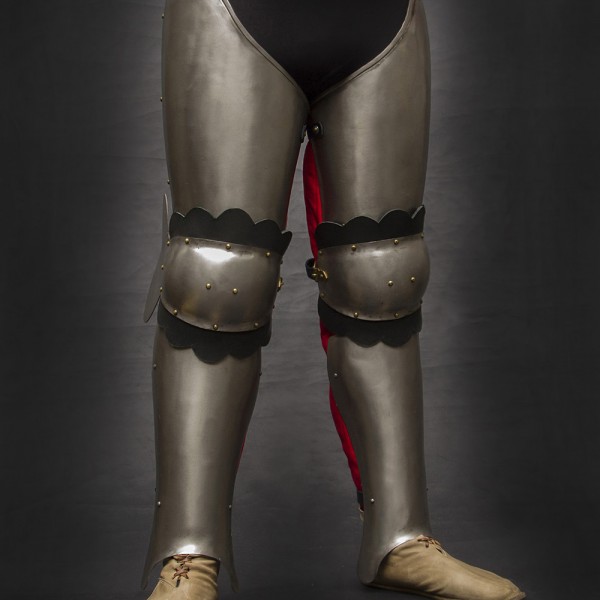Introduction: Understanding the Purpose of Leg Armor
Throughout history, armor has been a crucial component of what was the benefit of leg armor military, ceremonial, and even recreational wear. Among the various types of protective gear, leg armor served as a pivotal piece that protected warriors and soldiers in battle. Leg armor has shielded its wearers from potentially crippling injuries while also offering significant psychological and strategic advantages on the battlefield. In this article, we’ll delve into the multifaceted benefits of leg armor, both historical and contemporary, and explore how it has evolved in material, design, and purpose over centuries.
Historical Evolution of Leg Armor
Leg armor has been around for centuries, tracing back to ancient civilizations where protection was paramount in battle. Early forms of leg armor appeared in Ancient Greece and Rome, often crafted from bronze or iron. Over time, medieval armorers perfected leg protection with elaborate, articulated plates that allowed for both mobility and security. This progression continued through the Renaissance, where leg armor reached new heights of sophistication and artistry.
In the early days, armor was largely made by hand and tailored to each warrior’s needs. Greek hoplites wore “greaves,” or shin guards, while Roman legionaries had their own versions designed for extended campaigns. As time passed, medieval knights in Europe wore full suits of plate armor, including articulated leg coverings that moved with the joints, offering superior protection compared to earlier designs. This evolution showcases how leg armor was adapted to meet changing warfare tactics, such as the introduction of firearms, and further refined as protection became increasingly essential.
Types of Leg Armor Used in Ancient Times
- Greaves: Greaves, perhaps the most well-known form of leg armor, protected the shin area. Used by Greek, Roman, and even some Eastern warriors, greaves were typically crafted from bronze, iron, or leather. They protected vulnerable lower legs from bladed attacks and harsh impacts without restricting movement.
- Cuisses and Poleyns: As armoring technology advanced, medieval armorers introduced more sophisticated forms like cuisses (thigh protection) and poleyns (knee caps). These components were essential in mounted combat, where a rider’s legs were particularly exposed to attacks from below.
- Chausses: In medieval times, warriors often wore chainmail chausses, or leggings, which covered the legs and allowed for greater flexibility. Chausses were favored for their balance between mobility and defense, especially when knights were on foot or mounted.
Each of these types served specific roles, catering to the tactics and combat styles of their era. This diversity in leg armor types highlights the adaptability of armor design to protect various parts of the leg under different combat scenarios.
Materials Used in Leg Armor Construction
The construction materials for leg armor have varied significantly across time periods and regions. In ancient Greece and Rome, bronze and iron were the primary materials, favored for their durability and availability. As metallurgical technology advanced, steel became the preferred choice in medieval Europe, allowing for thinner, lighter, and stronger armor plates.
Bronze
Bronze was initially popular for its availability and ease of shaping. Though heavier than iron, it was used in Greece and Rome to make durable greaves that could be molded to fit the warrior’s leg shape.
Iron and Steel
With advancements in metalworking, iron and later steel became preferred materials due to their hardness and resistance to piercing. Steel armor, developed in the medieval period, offered exceptional protection against swords, lances, and arrows, while being less cumbersome than earlier options.
Leather and Fabric
Leather and padded fabric played supportive roles, often layered under metal armor to enhance comfort and shock absorption. These materials provided a buffer that absorbed impacts, reducing the force that reached the body.
Protection Against Physical Injury: The Primary Benefit of Leg Armor
Preventing Bone Fractures and Muscle Damage
The primary purpose of leg armor is to shield the legs from injury in combat. Historically, warriors risked severe fractures, muscle tears, and other injuries in battle. Leg armor, especially greaves, poleyns, and cuisses, provided necessary protection against direct blows, thereby reducing the likelihood of disabling injuries that could remove a soldier from battle or even cost him his life.
Defense Against Sharp and Blunt Weapons
Leg armor was particularly beneficial in repelling weapons like swords, spears, and arrows, which often aimed for exposed limbs. Additionally, many medieval battle techniques relied on powerful blows from blunt weapons, where leg armor mitigated the impact and prevented injuries that would otherwise lead to incapacitation.
Reducing Injuries During Mounted Combat
For mounted soldiers, legs were vulnerable to strikes from below. Riders benefited greatly from leg armor that protected against attacks from infantry and other mounted opponents. For instance, stirrup guards shielded ankles and calves, while cuisses and greaves kept thighs and shins safe.
Psychological Impact: Boosting Confidence and Morale
Instilling a Sense of Security

The presence of leg armor provided psychological benefits by instilling a sense of safety. Soldiers wearing protective gear felt more prepared to face the uncertainties of battle, allowing them to focus on combat tactics rather than self-preservation.
Increasing Aggressiveness and Combat Effectiveness
Wearing leg armor often emboldened warriors to engage more aggressively in battle. With the lower body shielded, soldiers felt encouraged to move with less fear of crippling injuries, improving their combat effectiveness and adding an intimidating presence on the field.
Boosting Morale in the Ranks
Seeing comrades equipped with effective leg armor could raise the morale of entire ranks, inspiring confidence among troops. Armored soldiers not only felt safer but also gained psychological strength from knowing their fellow warriors were similarly protected.
Articulated Plates for Enhanced Movement
Medieval leg armor incorporated articulated joints, allowing greater movement in the knees and ankles without sacrificing protection. Innovations like the poleyn (knee armor) permitted full knee bending, essential for both mounted and infantry soldiers who needed mobility to fight effectively.
Chainmail and Leather for Flexibility
Chainmail chausses and leather leggings allowed for flexibility, making these materials popular for archers, scouts, and other roles where agility was crucial. Chainmail provided decent protection with enough flexibility to crouch, kneel, or run, crucial for dynamic combat.
Balancing Weight and Mobility
As leg armor evolved, armorers experimented with materials and designs to maintain a balance between weight and functionality. The ability to maneuver, despite the armor’s weight, allowed soldiers to participate in prolonged battles, reducing fatigue while keeping the legs adequately protected.
How Leg Armor Influenced Military Tactics and Strategies
Adaptation of Combat Techniques
Leg armor allowed armies to incorporate new strategies, such as charging into close combat or holding defensive lines without worrying as much about leg injuries. For cavalry, leg armor was essential in adopting formations that exposed their legs to enemy attacks but offered significant offensive advantage.
Influence on Weapon Development
The presence of leg armor influenced the design of enemy weapons, leading to the development of weapons like poleaxes and maces that could penetrate or what was the benefit of leg armor crush armor. In response, leg armor continuously adapted to counter new weapon threats, showcasing a perpetual arms race in military equipment.
Tactical Positioning in Battles
Protected soldiers could hold ground longer, effectively altering battlefield tactics. Infantry outfitted with leg armor could form stronger defensive lines, while cavalry with leg armor could confidently charge enemy formations, changing the flow of engagements and leading to more decisive victories.
Role of Leg Armor in Ceremonial and Symbolic Functions
Ceremonial and Ornamental Armor
In addition to practical use, leg armor held symbolic value in many cultures. Leaders, knights, and high-ranking soldiers wore ornate leg armor during ceremonies, what was the benefit of leg armor reflecting status, honor, and the valor associated with military service. Such armor often featured engravings, symbols, and intricate designs showcasing rank or lineage.
Royal and Noble Affiliation
In medieval societies, owning high-quality armor signified nobility and status. Wealthier knights or those of royal lineage often wore leg armor adorned with family crests or intricate patterns, marking them as elite soldiers. This symbolism strengthened the association between armored knights and social hierarchy.
Preserving Armor in Legacy
Many families preserved leg armor as heirlooms, symbolizing strength and protection across generations. These pieces, displayed in castles or estates, what was the benefit of leg armor reminded descendants of their ancestral honor and the importance of bravery and protection in their lineage.
Economic Value and Social Status Associated with Leg Armor
Cost and Craftsmanship
High-quality leg armor was expensive, often what was the benefit of leg armor custom-made by skilled armorers. The cost of materials like steel, as well as the labor-intensive process of crafting fitted armor, meant only wealthy soldiers or nobility could afford the best protection. This exclusivity elevated the armor’s status and value.
Armor as a Measure of Wealth and Influence
Owning leg armor signified wealth and influence, as what was the benefit of leg armor the investment was substantial. In feudal societies, knights with full suits of armor were among the elite, granted land and power in exchange for military service, further elevating their status and societal role.
Social Symbolism in Warfare and Peace
In peaceful settings, leg armor functioned as a mark what was the benefit of leg armor of distinguished service or prowess in battle. what was the benefit of leg armor This added what was the benefit of leg armor social prestige, as even in civilian life, warriors retained the respect and deference afforded to those who defended the land with their lives.


